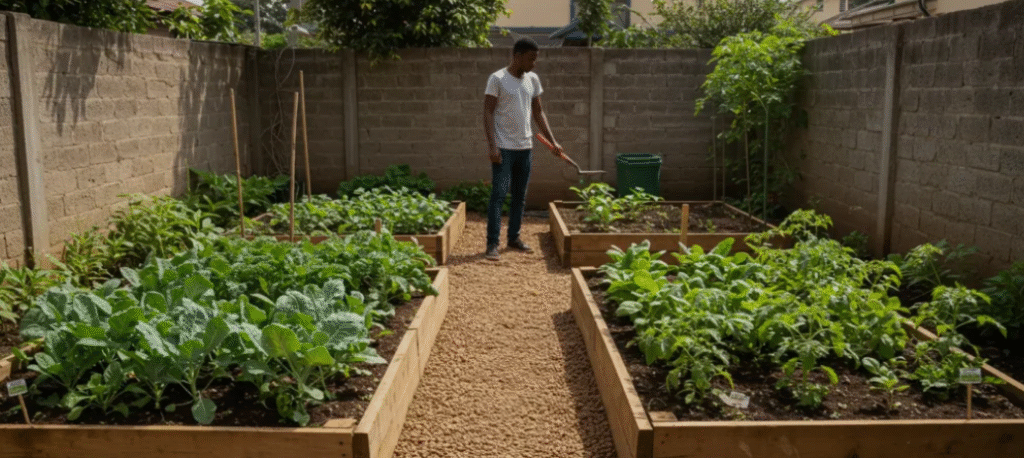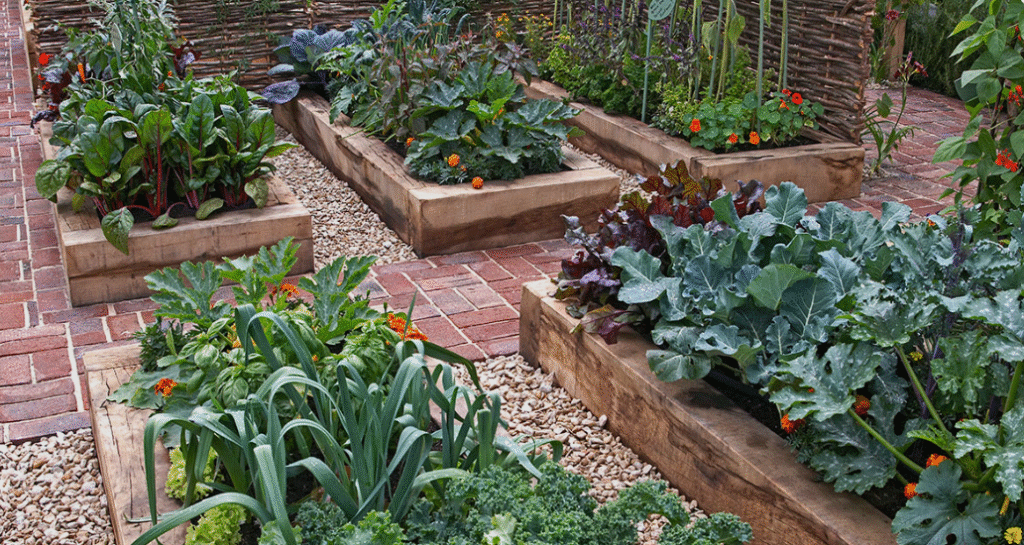
A kitchen garden is a small area for growing vegetables, fruits, and herbs for use in the home. These gardens are often located close to the kitchen for convenience and can include a wide variety of plants, from common vegetables like kale and tomatoes to herbs and edible flowers. The primary goal is to provide fresh, readily available ingredients for cooking, but they also offer benefits like stress reduction, physical activity, and eco-friendly food production.
The benefits of a kitchen garden extend far beyond the plate. It promotes a deeper connection to your food, from seed to harvest, ensuring you know exactly how your produce is grown. Gardening itself is a physical activity that reduces stress and can significantly cut grocery bills. The result is not just food, but a sense of accomplishment, better health, and a more sustainable lifestyle.
Usually a kitchen garden is not defined by its size but by its function. Whether it’s a collection of pots on a balcony, a raised bed in the yard, a vertical wall of herbs, or a few containers on a windowsill, anyone can cultivate a kitchen garden. This makes it accessible to everyone, from rural homeowners to urban apartment dwellers.
What you grow is entirely personalized to your culinary tastes and climate. Common staples include fast-growing herbs like basil and parsley, leafy greens like lettuce and spinach, and flavorful vegetables like tomatoes, peppers, and cucumbers. The selection is often driven by what tastes best fresh-picked and what is expensive or hard to find in local stores, maximizing both pleasure and practicality.

Kitchen Gardens
The Traditional In-Ground Plot
This is the classic image of a vegetable garden: a dedicated plot of tilled earth in the backyard.
- Key Features: Rows or blocks of vegetables, often requiring full sun (6-8 hours daily). It can be as large or as small as space allows.
- Best For: Gardeners with ample yard space who don’t mind bending and kneeling. It’s ideal for heavy-feeding crops like corn, squash, and potatoes.
- Pros: Low initial cost; great for large harvests; plants can develop deep root systems.
- Cons: Requires good native soil or significant amending; more weeding and pest control; not suitable for poor or contaminated soil.
Raised Bed Gardens
This is arguably the most popular method for modern home gardeners. A raised bed is a freestanding frame filled with soil, elevated above the ground level.
- Key Features: Constructed from wood, metal, stone, or composite materials. They are typically 1 to 3 feet high.
- Best For: Almost everyone! Especially those with poor, rocky, or contaminated soil; gardeners with mobility issues (less bending); and those who want better control over their soil quality.
- Pros: Excellent drainage; less soil compaction; easier weed and pest management; can extend the growing season as soil warms faster.
- Cons: Higher initial cost for materials and soil; soil can dry out faster and may require more frequent watering.
Container Gardens
The ultimate solution for small spaces. If you can put soil in it and it has drainage holes, it can be a container garden.
- Key Features: Uses pots, buckets, window boxes, grow bags, barrels, and even repurposed items like colanders.
- Best For: Apartment dwellers with balconies or patios, renters, and those with only a doorstep or windowsill to spare.
- Pros: Maximum flexibility and portability; perfect for small-scale growing; total control over soil medium.
- Cons: Limited root space for large plants; requires frequent watering and fertilizing; can be heavy.
Vertical Gardens
When horizontal space is limited, grow up! This method utilizes vertical structures to maximize yield in a small footprint.
- Key Features: Trellises, wall-mounted planters, pallet gardens, hanging baskets, tiered strawberry pots, and living walls.
- Best For: Urban gardeners, small patios, and anyone wanting to create a “green wall” for aesthetic appeal.
- Pros: Saves immense amounts of space; can improve air circulation around plants; reduces pest access; adds visual interest.
- Cons: Can dry out very quickly; requires secure mounting; may need drip irrigation for efficiency.
Herb Spirals
A permaculture favorite, the herb spiral is a compact, efficient, and beautiful way to grow a variety of herbs with different needs in one structure.
- Key Features: A spiraling mound of soil and stones, usually about 3-5 feet in diameter and 2-3 feet high. It creates multiple microclimates.
- Best For: Gardeners interested in permaculture principles and those who want a focal point in their garden.
- Pros: Maximizes growing area in a small space; the top is dry and sunny (for rosemary, thyme), the middle is moist (for oregano, chives), and the bottom is shady and damp (for parsley, mint).
- Cons: Requires some effort and skill to build correctly; not easily movable.
Indoor Kitchen Gardens
Bring the garden inside for year-round fresh picks, regardless of the weather.
- Key Features: Grown on windowsills, under grow lights, or in dedicated hydroponic countertop units.
- Best For: Anyone without outdoor space or those in cold climates wanting fresh greens in winter.
- Pros: Year-round harvesting; herbs and greens are always within arm’s reach; protected from pests and weather.
- Cons: Limited to smaller plants and herbs; requires good light (natural or artificial); humidity and pollination can be challenges.
Potager (Ornamental Kitchen Garden)
A French term for a garden that blends beauty with utility. The potager is designed to be aesthetically pleasing, where vegetables, herbs, fruits, and flowers are interplanted.
- Key Features: Geometric designs, repeating color patterns, use of decorative elements, and a mix of edible and ornamental plants.
- Best For: Gardeners who view their garden as an extension of their home’s decor and enjoy creative design.
- Pros: Highly productive and beautiful; companion planting can reduce pests; flowers attract pollinators.
- Cons: Requires more planning and design effort; can be more labor-intensive to maintain the “manicured” look.
Hydroponic & Aquaponic Gardens
A soilless method of gardening that uses nutrient-rich water to grow plants. Aquaponics adds fish to the system, whose waste provides the nutrients.
- Key Features: Systems range from simple Kratky jars (passive) to complex recirculating systems with pumps and grow lights.
- Best For: Tech-savvy gardeners, those with poor soil, or anyone interested in high-efficiency, year-round food production.
- Pros: Faster plant growth and higher yields; uses up to 90% less water; no weeding; can be set up anywhere.
- Cons: High initial cost for good systems; requires electricity and monitoring of water pH/nutrients; has a learning curve.
Keyhole Gardens
Originating in Africa, a keyhole garden is a circular raised bed with a compost basket at its center, resembling a keyhole when viewed from above.
- Key Features: A notch in the bed allows easy access to the central compost basket. As you water the garden, nutrients from the composting materials leach into the surrounding soil.
- Best For: Arid climates and areas with poor soil; it’s an efficient, self-fertilizing system.
- Pros: Extremely water-efficient; continuous nutrient supply from the compost core; can be built from recycled materials.
- Cons: The structure can be labor-intensive to build initially; the compost core needs to be replenished.
Square Foot Gardening (SFG)
This is a highly organized and intensive planting method developed by Mel Bartholomew. It maximizes yield in a minimal space using a specific soil mix.
- Key Features: A raised bed is divided into a grid of 1-foot by 1-foot squares. Each square is planted with a different crop, using a specific number of plants per square (e.g., 16 carrots, 1 cabbage, 4 lettuce).
- Best For: Beginners, those with very limited space, and anyone who loves organization and wants to eliminate waste.
- Pros: Minimal weeding; very efficient use of space, seeds, and water; easy to plan and manage.
- Cons: Can be too rigid for some gardeners; the initial “Mel’s Mix” soil blend (1/3 compost, 1/3 peat moss, 1/3 vermiculite) can be costly.
Straw Bale Gardens
A form of “lasagna gardening” where you use a straw bale as both the container and the growing medium.
- Key Features: The bale is “conditioned” with water and nitrogen fertilizer for 10-14 days to start internal decomposition, which creates a warm, nutrient-rich planting medium.
- Best For: Gardeners with terrible soil, poor drainage, or limited mobility (the bales are waist-high).
- Pros: No weeding or tilling; excellent drainage and aeration; the bales warm up quickly, allowing for early planting.
- Cons: Requires a precise conditioning process; bales need consistent watering as they dry out fast; they are temporary, lasting only one or two seasons.
Community Garden Plot
A kitchen garden doesn’t have to be at your home. This type involves renting a small plot in a larger, shared garden managed by a community group or local government.
- Key Features: Individual plots within a fenced-in area, often with shared tools, water access, and a communal shed.
- Best For: People without sunny yards (apartment dwellers, renters) and those who enjoy the social aspect of gardening.
- Pros: Access to land and shared resources; knowledge sharing with fellow gardeners; fosters a sense of community.
- Cons: Not as convenient as a backyard garden; may have rules to follow; potential for theft or vandalism.
Edible Landscaping
This approach integrates food-producing plants directly into your ornamental landscape, replacing purely decorative plants with beautiful edibles.
- Key Features: Fruit trees as shade trees, blueberry bushes as hedges, Swiss chard and red lettuce in flower beds, and strawberry plants as ground cover.
- Best For: Homeowners who want a beautiful yard but also wish to maximize their property’s productivity.
- Pros: Maximizes the utility of your entire property; can be surprisingly low-maintenance; blurs the line between “garden” and “yard.”
- Cons: Requires thoughtful design to be aesthetically pleasing; harvesting might be more spread out.
Windowsill & Microgreen Gardens
The ultimate in hyper-local, quick-turnaround food production. This focuses on growing sprouts, microgreens, and small herbs right in your kitchen.
- Key Features: Shallow trays or jars placed on a sunny windowsill or under a small grow light. Microgreens are harvested just after the first true leaves appear, packed with nutrients.
- Best For: Anyone, regardless of space. Perfect for adding fresh, intense flavors and nutrients to meals year-round.
- Pros: Extremely fast (harvest in 1-3 weeks); incredibly space-efficient; very low cost.
- Cons: Very small yields per planting; constant succession planting is needed for a steady supply.
Rooftop Gardens
A fantastic way to utilize unused urban space, transforming barren rooftops into productive green oases.
- Key Features: Typically uses containers, raised beds, or even large, shallow green roof systems. Weight, wind, and water access are major considerations.
- Best For: Urban dwellers with access to a flat, sturdy roof (always check structural capacity first!).
- Pros: Creates a valuable green space in a concrete environment; can reduce building cooling costs; often has excellent sun exposure.
- Cons: Can be expensive and complex to set up safely; exposure to extreme wind and sun; requires reliable water access.
Foraged & “Volunteer” Gardens
This is a less formal, more opportunistic type of kitchen gardening. It involves identifying and nurturing edible plants that naturally occur in your yard or neighborhood (where safe and legal) and allowing “volunteer” plants from last year’s seeds to grow.
- Key Features: Not a planted garden, but a curated one. It might include dandelion greens, purslane, or wild berries, plus tomato and squash plants that sprouted from your compost.
- Best For: The observant, low-intervention gardener who enjoys a surprise and has a good knowledge of plant identification.
- Pros: Zero cost; promotes local biodiversity and native plants; teaches you about the local ecosystem.
- Cons: Critical: Requires expert-level knowledge to avoid poisonous plants; risk of contamination from pesticides or pollutants.